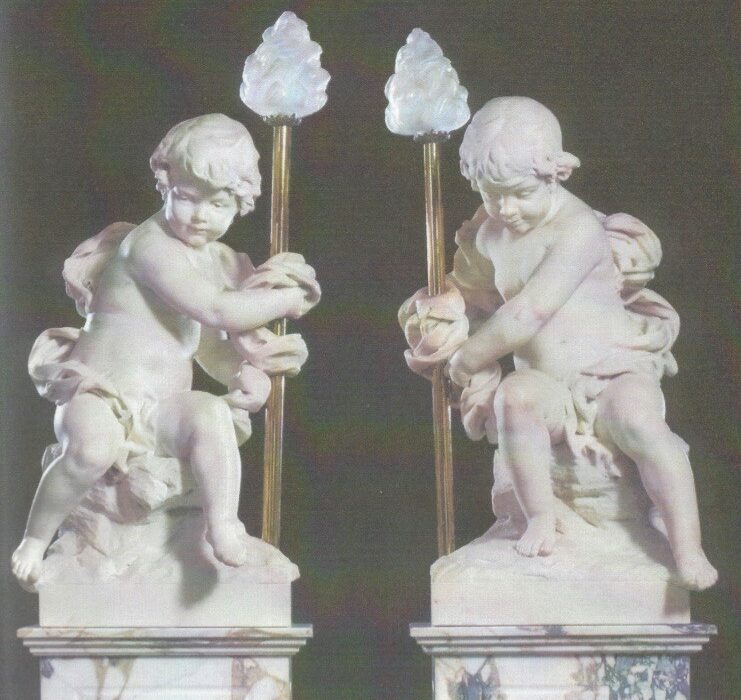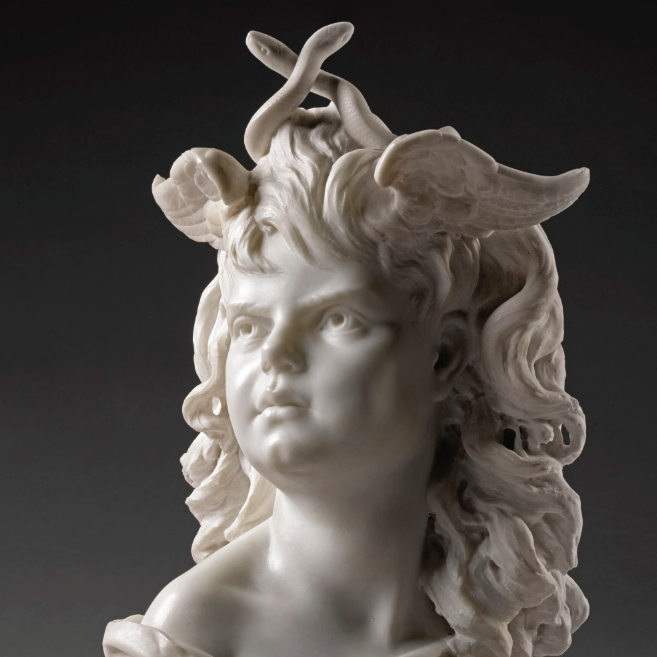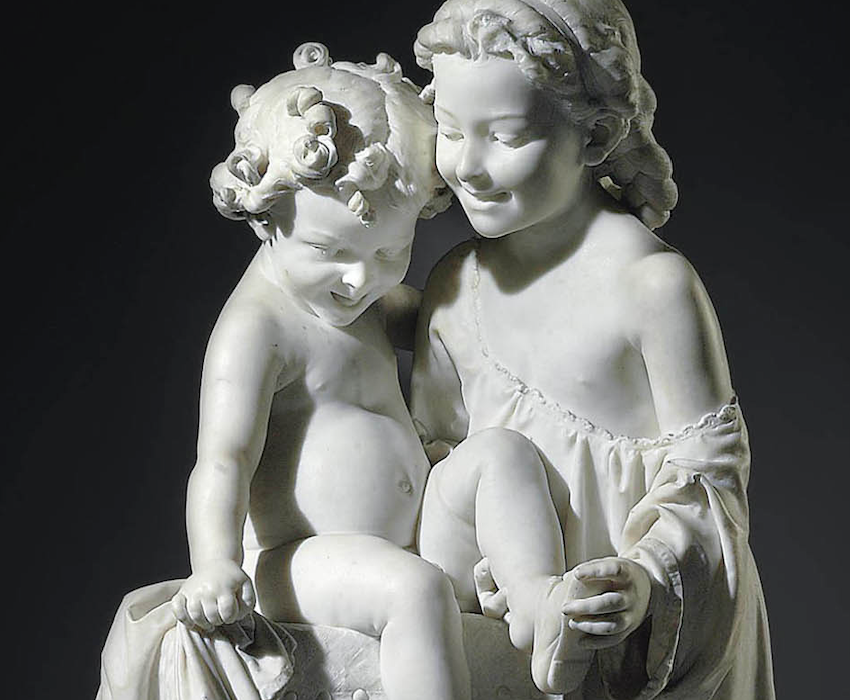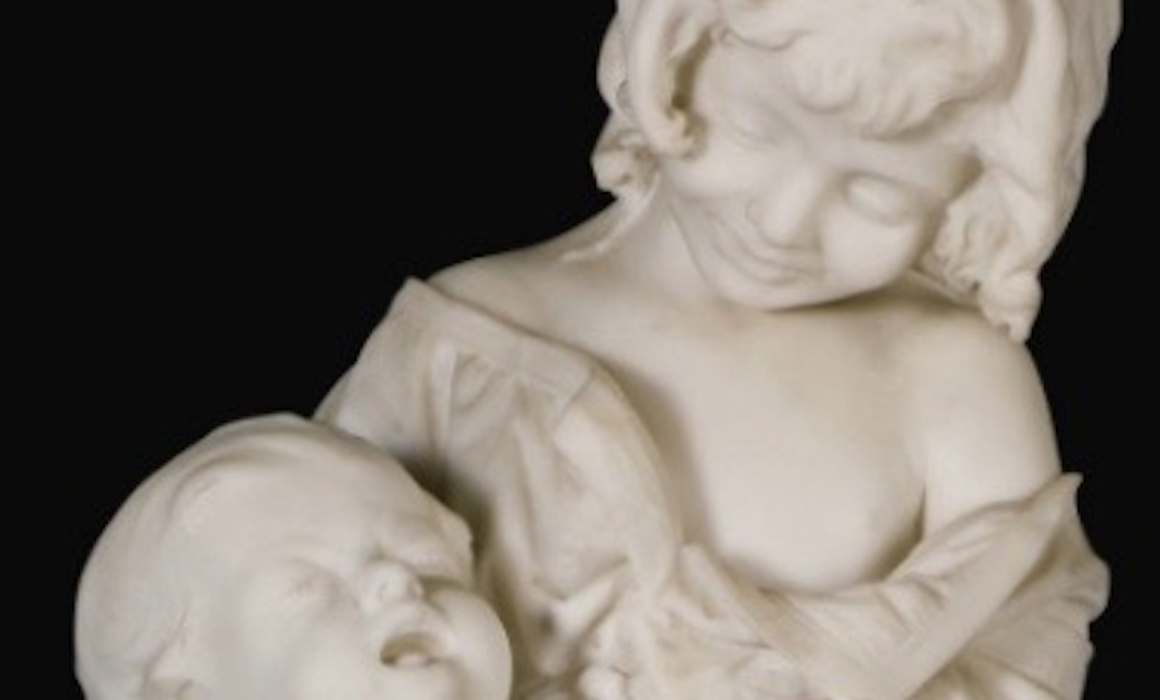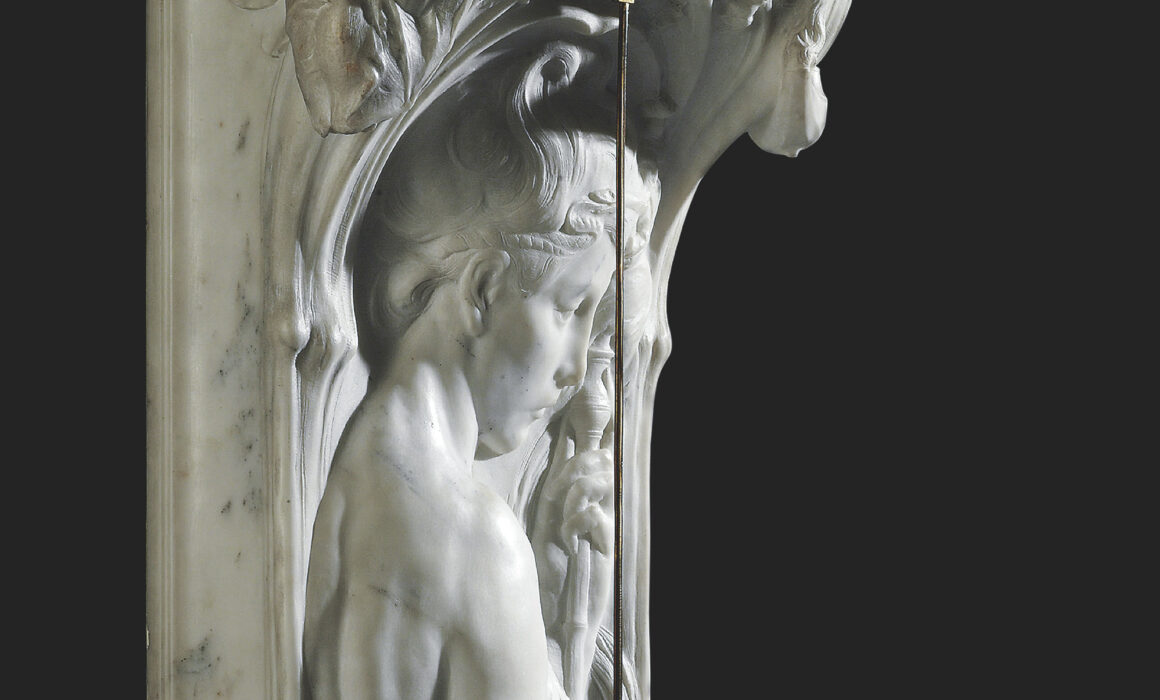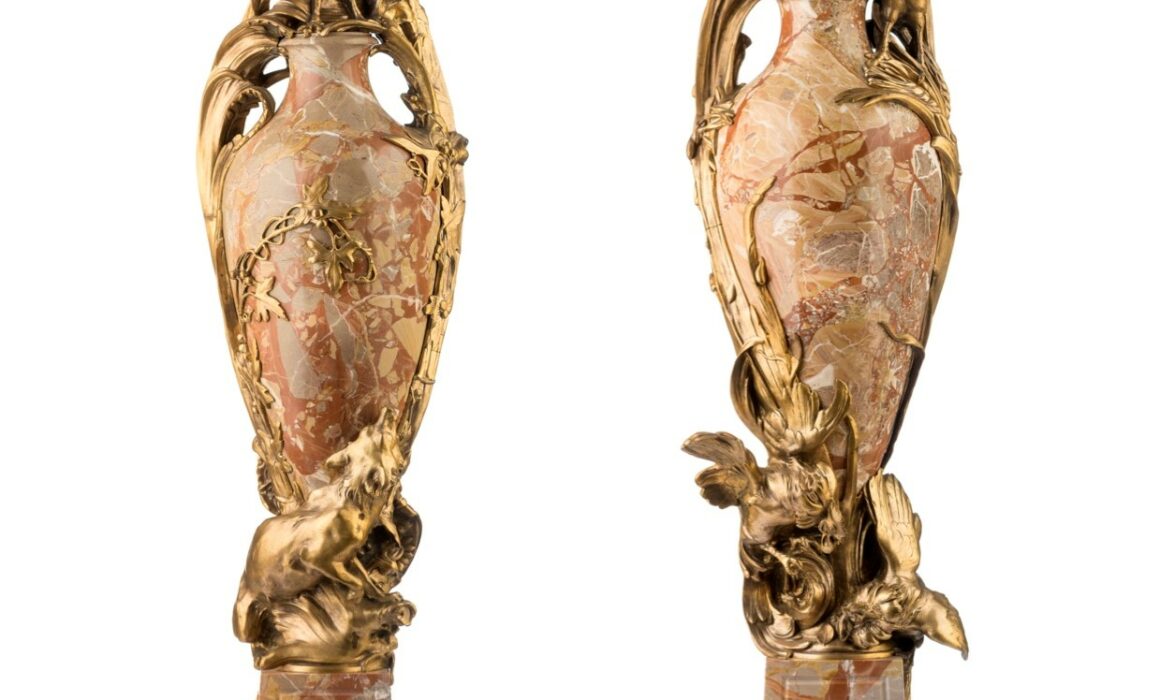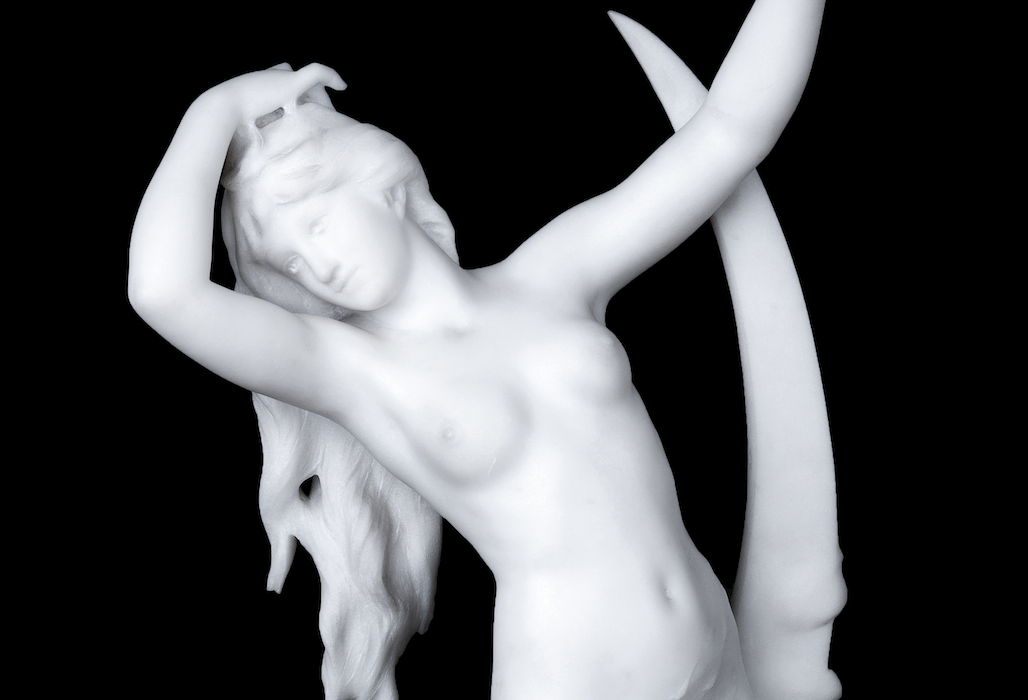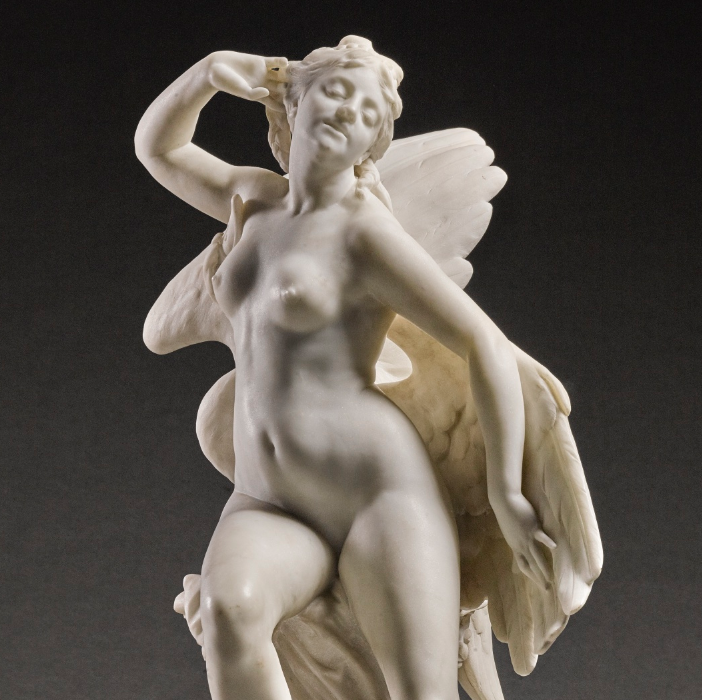HERMIONE BY SARAH BERNHARDT

Hermione
BY SARAH BERNHARDT
Description
Extremely rare marble sculpture signed « Sarah Bernhardt 1875 ».
Sold to a private collector.
Material:
-
- White Carrara marble
Dimensions:
-
- Height sculpture : 46 cm
- Height base : 20 cm
Period:
-
- French, 1875.
TWO CHILDREN PLAYING WITH A CAT BY GIULIO MONTEVERDE

TWO CHILDREN PLAYING WITH A CAT BY GIULIO MONTEVERDE
Description
Marble sculpture made by Guilio Monteverde (1837 – 1917), with its original green Serpentine marble column. Marble sculpture signed « GIULIO MONTEVERDE PECE IN ROMA 1869 » with original green Serpentine marble column.
Sold to a private collector from London.
Material:
-
- White Carrara marble.
- Original Column : green Serpentine marble.
Dimensions:
-
- Height : 100, 00cm
- Column : 70,00 cm
Period:
-
- Italian, 1869.
Provenance:
-
- Previously in the Gilgore Collection.
BATH TIME BY RAFFAELLO ROMANELLI
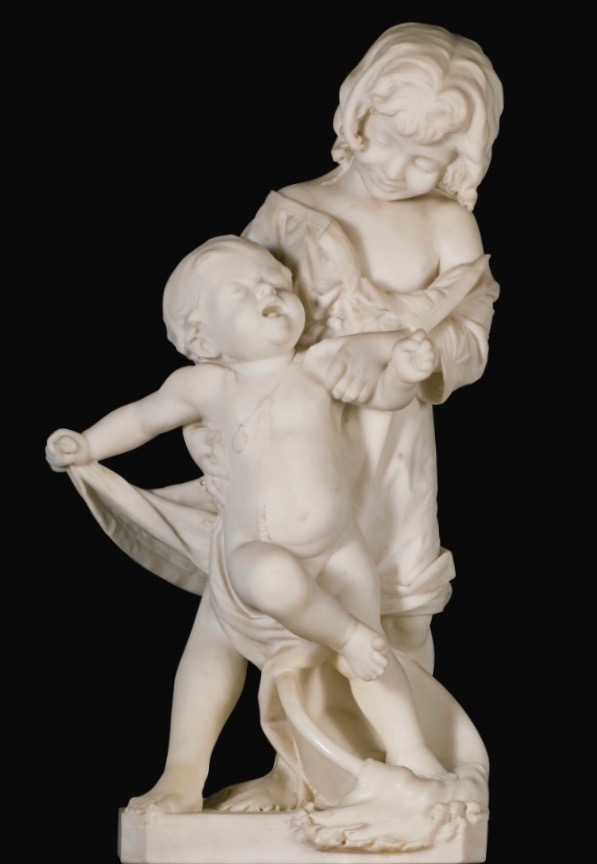
BATH TIME
BY RAFFAELLO ROMANELLI
Description
Marble sculpture by Raffaello Romanelli representing two children going to bath. The older child is bathing the younger child who loses balance while the basin slides under his feet. As he loses balance, he clings to the clothes of her older brother who catch him up to help him.
The marble sculpture is signed « R.Romanelli” which stands for Raffaello Romanelli (1856 – 1928).
The italian sculptor Raffaello Romanelli (1856 – 1928)
Raffaello, who’s father was the famous sculptor Pasquale Romanelli, started his training at the Accademia di Belle Arti in Florence with Augusto Rivalta as teacher.
The quality, finesse and details present in this sculpture show how well Romanelli and his workshop were able to work with marble. There is no doubt that the attention paid to the sculptures signed by the master Raffaello Romanelli was much more important than that of other artists. These sculptures were to represent the artistic quality of the sculptor but also the expertise of the workshop on the international scene.
Material:
-
- White Carrara marble
Dimensions:
-
- Height : 76,00 cm
Period :
-
- Italian, end of the 19th ca.
MARBLE ART NOUVEAU CLOCK BY EGIDE ROMBAUX

MARBLE ART NOUVEAU CLOCK
BY EGIDE ROMBAUX
Description
Impressive art nouveau marble clock by the artist Egide Rombaux. Marble regulator depicting Atropos, the goddess of fate and destiny in Greek mythology.
Sold to a London private collector.
The Belgian sculptor Egide Rombaux (Schaarbeek 1865 – Uccle 1942)
These vases by Egide Rombaux are without reservation among the highlights of his oeuvre and at the same time one of the icons of Belgian Art Nouveau.
Material:
-
- White Carrara marble
Dimensions:
-
- Height: 240 cm
Period:
-
- Belgian, ca. 1905
Provenance:
-
- Du Moulin-Joinville, Château de l’Escaille, Charleroi, Belgium.
PAIR OF VASES FABLES OF JEAN DE LA FONTAINE BY EGIDE ROMBAUX

PAIR OF VASES FABLES OF JEAN DE LA FONTAINE
BY EGIDE ROMBAUX
Description
These vases by Egide Rombaux are without reservation among the highlights of his oeuvre and at the same time one of the icons of Belgian Art Nouveau. Everything about this works of art is infused with spirit and an ode to what those aiming for the purest refinement can only dream of.
These vase are now the property of a private collector.
The Belgian sculptor Egide Rombaux (Schaarbeek 1865 – Uccle 1942)
These vases by Egide Rombaux are without reservation among the highlights of his oeuvre and at the same time one of the icons of Belgian Art Nouveau.
Material:
-
- White Carrara marble
Dimensions:
-
- 1st Vase : 87,50 x 26,00 x 22,00 cm.
- 2nd Vase : 82,00 x 25,00 x 22,00 cm.
Period:
-
- Belgian, ca. 1900
THE AWAKENING BY CHARLES OCTAVE LEVY

THE AWAKENING
BY CHARLES OCTAVE LEVY
Description
Levy’s The Awakening captures the brief moment between sleep and waking. Rendered in white marble, the figure of a woman rests on a crescent moon, representing the night, while the flowers in her hand reach for the day. This elegant sculpture is alive with movement. The figure’s partially draped body reveals the arch of her back and her hair flows below her as she opens her eyes. This sculpture was exhibited during the Salon of Paris in 1896 and is considered one of his finest works.
The french sculptor Charles Octave Levy (1820-1899)
Signed « CH.LEVY», « Le Réveil » is by Charles Octave Levy (1820-1899). Born in Paris, he was a student of the sculptor Armand Toussaint (1806-1862). Levy exhibited several of his works at the Salon between 1873 and 1898 including: «Source» (1888) and «La Paix» (1898) both in plaster; «Naïde» (1889), «Le Réveil» (1896) both in marble; and «Faneur et Captif» (1890) in bronze. Levy also reproduced many of his bronzes in different sizes; not so his marble sculptures which are unique.
Material:
-
- White Carrara marble
Dimensions:
-
- Height : 74,50 cm
- Width : 29,00 cm
- Depth : 25,00 cm
THE SPIRIT OF SEAFARING BY JEAN-BAPTISTE -JOSEPH DE BAY

The SPIRIT OF SEAFARING
by jean-Baptiste -joseph de bay
Description
Impressive marble sculpture by Jean de Bay representing the allegory of the sea by depicting a Cupid braving the current in a small shell-shaped boat. He steers with an oar, sitting on a folded sail next to an anchor. Cupid’s determination to follow his own course and speed, with no desire to stop, may allude to the persistence of love against all odds.
The french sculptor Jean-Baptiste-Joseph de Bay (1802 – 1862)
With the same name as his sculptor father, Jean De Bay was born in Nantes on 31 August 1802. A pupil of his father and Baron Bosio, he entered the École des Beaux-Arts on the 22nd of December 1820. Jean De Bay received a first class medal in 1836 and a second class medal at the Universal Exhibition in Paris in 1855. He was made a knight of the Legion of Honour on the 25th of May 1851.
He died in Paris, at his home, 75, rue Notre-Dame-des-Champs, on 7 January 1862, leaving some sculptures unfinished, which were ultimately completed by his brother Auguste De Bay.
Material:
-
- White Carrara marble.
Dimensions:
-
- Height: 101 cm.
- Width: 85 cm.
- Depth: 48 cm.
Period:
-
- 1832
LEDA AND THE SWAN BY EDOUARD HOUSSIN
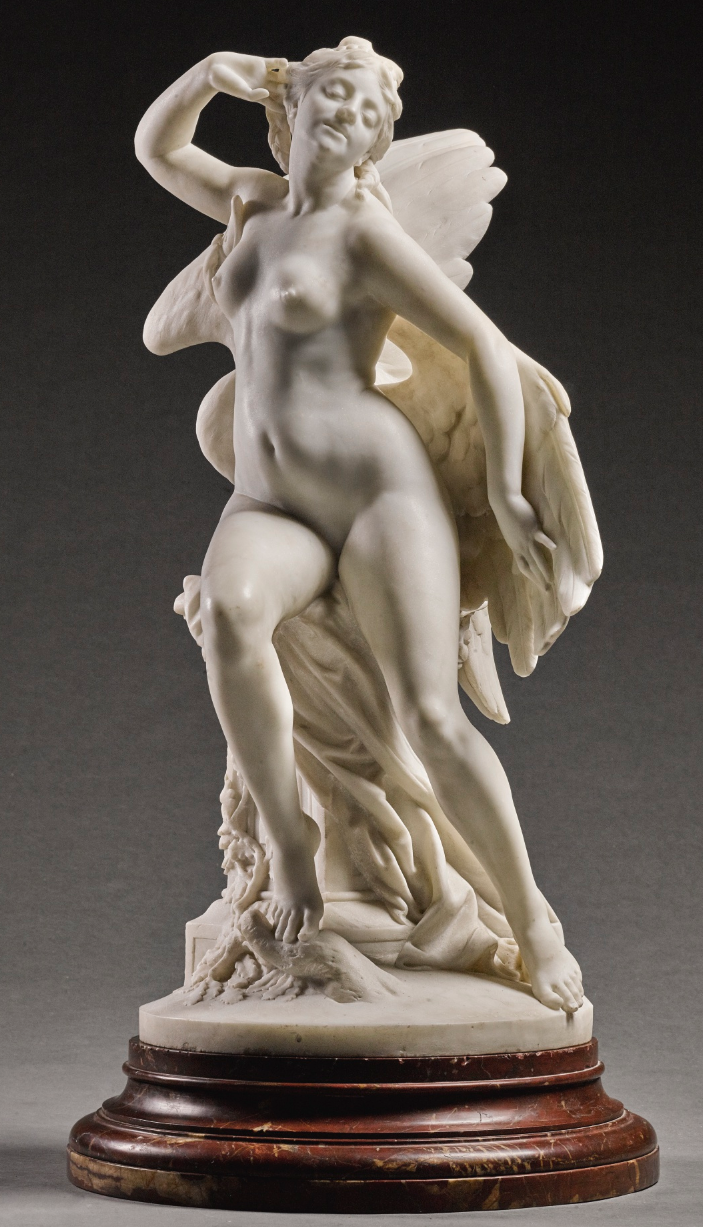
LEDA AND THE SWAN BY EDOUARD HOUSSIN
Description
The present sculpture represents the mythological story of Leda, a princess of Sparta who was seduced by Jupiter. In order to approach her, Jupiter transformed into a swan. Leaning back in ecstasy as she feels the soft plumage of the gently advancing swan behind her, Leda appears to willingly surrender to Jupiter’s seduction. A beautiful representation of female sensuality, this myth was depicted by some of the greatest artists in history going back as far as Leonardo da Vinci, Michelangelo and Raphael.
Reminding us in some ways of the Dance by Carpeaux, the present composition was inspired by Carpeaux’s Leda with the anatomical curves and the characteristic smile that illuminates the face. The diagonal line crossing Leda’s body creates a dynamic movement typical of Romanticism. The subject of Leda and the Swan is well known in art. It allows a very sensual representation that often pleases the viewer. The plaster model of Houssin’s “Léda” won an award at the Salon des Artistes Français in 1887. Thanks to its success, it was made in marble the following year. It is also without doubt Houssin’s most important surviving sculpture.
The french sculptor Edouard Houssin (1847 – 1917)
The sculpture is signed « E. Houssin 1888 ». Edouard Houssin (1847 – 1917) was born in Douai. He attended classes at the Douai Academic Schools in 1856, receiving many awards. In 1864 he moved to Paris where he was admitted to the « Ecole des beaux-arts » in 1866 in the workshops of Henri Lemaire and François Jouffroy.
In 1868, he exhibited for the first time a bust at the « Société des amis des arts de Douai ». From 1871 to 1877, he was appointed professor of sculpture at the Douai Art Schools. In 1873 he began to show his work at the Paris Salon, where he was awarded medals in 1887 and 1889. His commissions were largely centred on his native northern France. It included a number of monuments, as well as several figures in the Douai Museum.
At the beginning of 1894, he was appointed professor of modelling at the Manufacture nationale de Sèvres, a position he held until his death in 1919. On January 17, 1894, he participated in the conference followed by a banquet, organized by Charles Bodinier at the Théâtre d’Application, in honour of the poet Marceline Desbordes-Valmore with Paul Verlaine, Émile Gallé, Robert de Montesquiou and other personalities from the arts world. It was during this conference that the idea of a monument to the poetess was launched. He built the Monument to Marceline Desbordes-Valmore, inaugurated on July 13, 1896 in Douai.
Édouard Houssin has carried out numerous public commissions, particularly in northern France. In 1895, Fernand Lefranc wrote in « La Revue du Nord » : « His busts, all of them are of impeccable accuracy and admirably executed». Houssin’s monuments include Child with a panther (1881), Esmeralda (1883) Phaeton (1889), Loïe Fuller (1897), Saint Ignace (Braines) bronze cast by the Denonvilliers art foundry in 1888, the Lifeboat (1904).
He was a talented and well-known artist during his lifetime. Unfortunatly, the destruction and theft of nearly 90% of his work during the two great wars made him a relatively unknown artist today. As such, works by this artist are extremely rare and often heavily restored.
Mr Arnaud Debève, in charge of patronage for the Louvre Lens Museum, wrote the catalogue raisonné of the artist entitled « La Vie et l’Œuvre du sculpteur Édouard Houssin (1847-1919) » published in 2006. This testifies to the importance of the artist and the quality of his work.
Some sculptures of Houssin can be found in museums such as :
-
- Man throwing a stone, Douai Museum
-
- Love stung by a bee, Douai Museum
-
- Léda, La Rochelle Museum
Material:
-
- White Carrara marble.
Dimensions:
-
- Height : 98,00 cm
- Width: 55,00 cm
- Depth: 50,50 cm
Period:
-
- 1888
CIRCÉ BY ALEXANDRE FALGUIÈRE
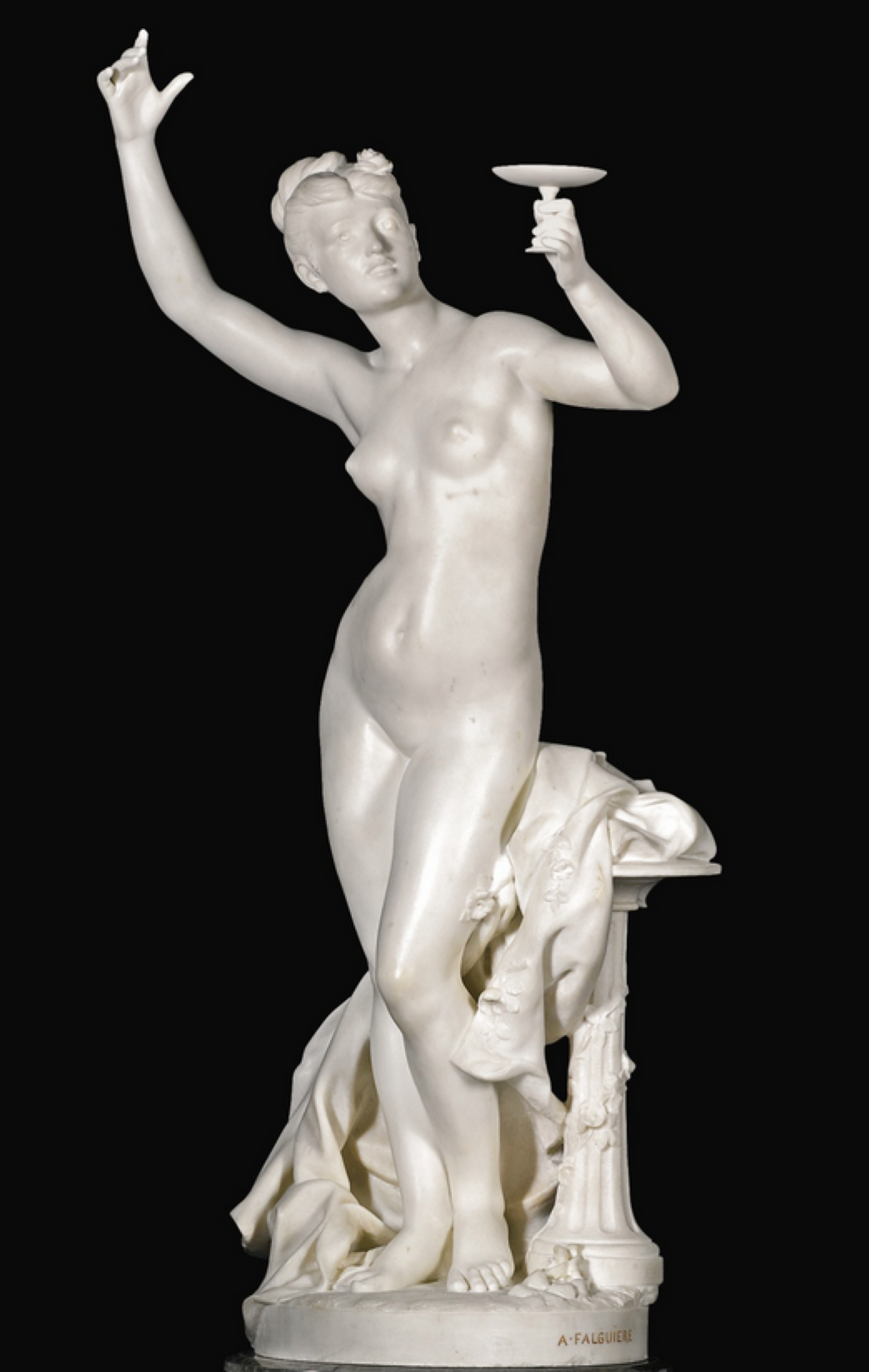
CIRCÉ BY ALEXANDRE FALGUIÈRE
Description
This marble sculpture called « Circé » was made by Alexandre Falguière (1831-1900).
The french sculptor Alexandre Falguière (1831-1900).
He is one of the major french sculptor of the 3rd Republic in France. He studied at the Beaux art in Paris and became the disciple of Francois Jouffroy and Albert-Ernest Carrier-Belleuse. In 1859, he won the Grand prix de Rome. After that, he gained fame thanks to two sculptures : Tarcicius and Le vainqueur du combat de coq. Nowadays, you can find most of his works in museums and squares all around France.
This sculpture is now the property of a chinese private collector.
Material:
-
- White Carrara marble.
Dimensions:
-
- Height : 99,00 cm
Period:
-
- ca. 1920
Signature:
-
- Late 19th century
Archives
Catégories
- Aucune catégorie
